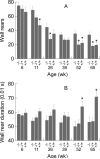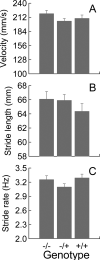Use of a force-sensing automated open field apparatus in a longitudinal study of multiple behavioral deficits in CAG140 Huntington's disease model mice
- PMID: 26210937
- PMCID: PMC4564309
- DOI: 10.1016/j.bbr.2015.07.036
Use of a force-sensing automated open field apparatus in a longitudinal study of multiple behavioral deficits in CAG140 Huntington's disease model mice
Abstract
Behavioral testing of mouse models of Huntington's disease (HD) is a key component of preclinical assessment for potential pharmacological intervention. An open field with a force plate floor was used to quantify numerous spontaneous behaviors in a slowly progressing model of HD. CAG140 (+/+, +/-, -/-) male and female mice were compared in a longitudinal study from 6 to 65 weeks of age. Distance traveled, wall rears, wall rear duration, number of low mobility bouts, in-place movements, number of high velocity runs, and gait parameters (stride rate, stride length, and velocity) were extracted from the ground reaction forces recorded in 20-min actometer sessions. Beginning at 11 weeks, HD mice (both +/- and +/+) were consistently hypoactive throughout testing. Robust hypoactivity at 39 weeks of age was not accompanied by gait disturbances. By 52 and 65 weeks of age the duration of wall rears increased and in-place tremor-like movements emerged at 65 weeks of age in the +/+, but not in the +/- HD mice. Taken together, these results suggest that hypoactivity preceding frank motor dysfunction is a characteristic of CAG140 mice that may correspond to low motivation to move seen clinically in the premanifest/prediagnostic stage in human HD. The results also show that the force plate method provides a means for tracking the progression of behavioral dysfunction in HD mice beyond the stage when locomotion is lost while enabling quantification of tremor-like and similar in-place behaviors without a change in instrumentation. Use of force plate actometry also minimizes testing-induced enrichment effects when batteries of different tests are carried out longitudinally.
Keywords: CAG140 knock-in mouse; Distance traveled; Force plate; Gait; Huntington’s disease; Power spectra.
Copyright © 2015 Elsevier B.V. All rights reserved.
Figures








Similar articles
-
Force-plate quantification of progressive behavioral deficits in the R6/2 mouse model of Huntington's disease.Behav Brain Res. 2009 Aug 24;202(1):130-7. doi: 10.1016/j.bbr.2009.03.022. Epub 2009 Mar 28. Behav Brain Res. 2009. PMID: 19447289 Free PMC article.
-
Treadmill exercise delays the onset of non-motor behaviors and striatal pathology in the CAG140 knock-in mouse model of Huntington's disease.Neurobiol Dis. 2017 Sep;105:15-32. doi: 10.1016/j.nbd.2017.05.004. Epub 2017 May 11. Neurobiol Dis. 2017. PMID: 28502806
-
Treadmill exercise rescues mitochondrial function and motor behavior in the CAG140 knock-in mouse model of Huntington's disease.Chem Biol Interact. 2020 Jan 5;315:108907. doi: 10.1016/j.cbi.2019.108907. Epub 2019 Nov 26. Chem Biol Interact. 2020. PMID: 31778667
-
Measuring movement in health and disease.Brain Res Bull. 2022 Apr;181:167-174. doi: 10.1016/j.brainresbull.2022.01.021. Epub 2022 Feb 2. Brain Res Bull. 2022. PMID: 35122899 Review.
-
[Locomotion disturbances in Huntington's disease].Rev Neurol (Paris). 2010 Feb;166(2):213-20. doi: 10.1016/j.neurol.2009.05.013. Epub 2009 Jul 14. Rev Neurol (Paris). 2010. PMID: 19604530 Review. French.
Cited by
-
Cholinergic interneurons in the Q140 knockin mouse model of Huntington's disease: Reductions in dendritic branching and thalamostriatal input.J Comp Neurol. 2016 Dec 1;524(17):3518-3529. doi: 10.1002/cne.24013. Epub 2016 Jun 6. J Comp Neurol. 2016. PMID: 27219491 Free PMC article.
-
Social housing protects against age-related working memory decline independently of physical enrichment in rats.Neurobiol Aging. 2019 Mar;75:117-125. doi: 10.1016/j.neurobiolaging.2018.11.016. Epub 2018 Nov 23. Neurobiol Aging. 2019. PMID: 30557770 Free PMC article.
-
A Novel Rat Model of ADHD-like Hyperactivity/Impulsivity after Delayed Reward Has Selective Loss of Dopaminergic Neurons in the Right Ventral Tegmental Area.Int J Mol Sci. 2023 Jul 8;24(14):11252. doi: 10.3390/ijms241411252. Int J Mol Sci. 2023. PMID: 37511013 Free PMC article.
-
Modeling tics in rodents: Conceptual challenges and paths forward.J Neurosci Methods. 2017 Dec 1;292:12-19. doi: 10.1016/j.jneumeth.2017.02.007. Epub 2017 Feb 22. J Neurosci Methods. 2017. PMID: 28237575 Free PMC article. Review.
-
Targeted deletion of GD3 synthase protects against MPTP-induced neurodegeneration.Genes Brain Behav. 2017 Jun;16(5):522-536. doi: 10.1111/gbb.12377. Epub 2017 Apr 18. Genes Brain Behav. 2017. PMID: 28239983 Free PMC article.
References
-
- The Huntington's Disease Collaborative Research Group A novel gene containing a trinucleotide repeat that is expanded and unstable on Huntington's disease chromosomes. Cell. 1993;72(6):971–83. PMID: 8458085. - PubMed
-
- Menalled L, Lutz C, Ramboz S, Brunner D, Lager B, Noble S, Park L, Howland D. A field guide to working with mouse models of Huntington's Disease. 2014 Chdifoundation.org.
-
- Menalled LB, Kudwa AE, Miller S, Fitzpatrick J, Watson-Johnson J, Keating N, Ruiz M, Mushlin R, Alosio W, McConnell K, Connor D, Murphy C, Oakeshott S, Kwan M, Beltran J, Ghavami A, Brunner D, Park LC, Ramboz S, Howland D. Comprehensive behavioral and molecular characterization of a new knock-in mouse model of Huntington's disease: zQ175. PLoS One. 2012;7(12):e49838. PMID: 23284626. - PMC - PubMed
-
- Fowler SC, Birkestrand BR, Chen R, Moss SJ, Vorontsova E, Wang G, Zarcone TJ. A force-plate actometer for quantitating rodent behaviors: illustrative data on locomotion, rotation, spatial patterning, stereotypies, and tremor. J Neurosci Methods. 2001;107(1-2):107–24. PMID: 11389948. - PubMed
Publication types
MeSH terms
Grants and funding
LinkOut - more resources
Full Text Sources
Other Literature Sources
Medical
Molecular Biology Databases

